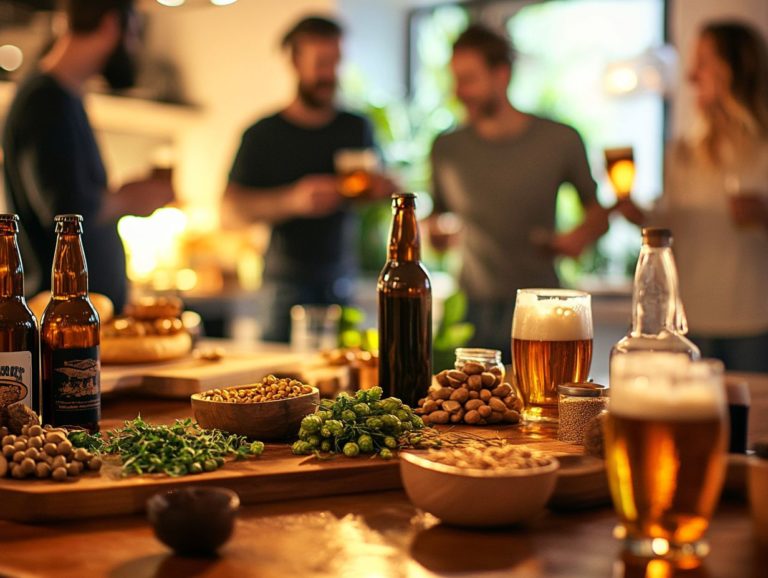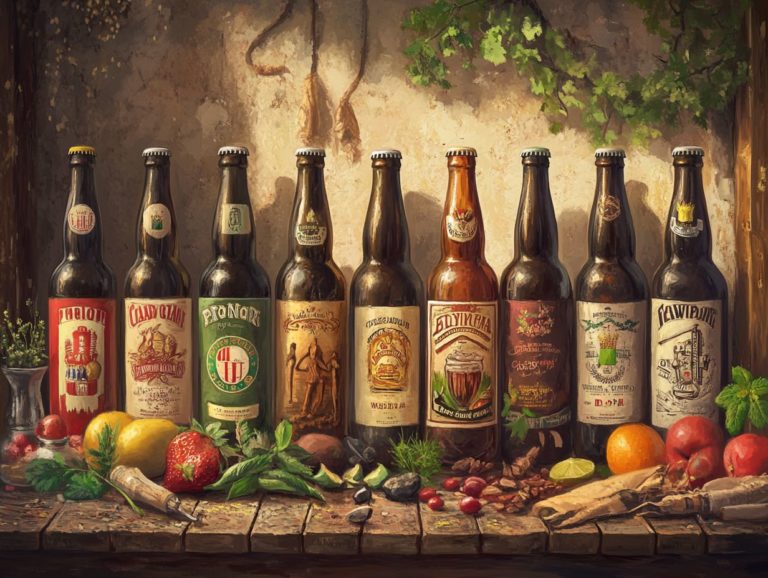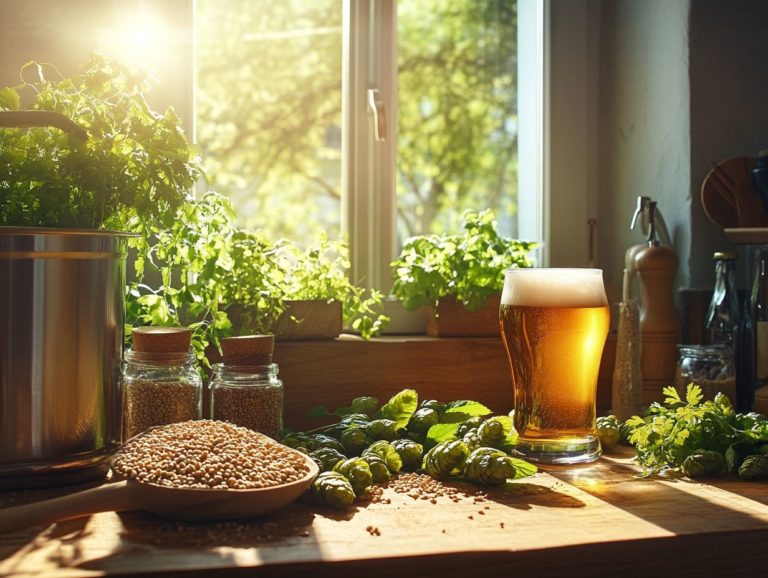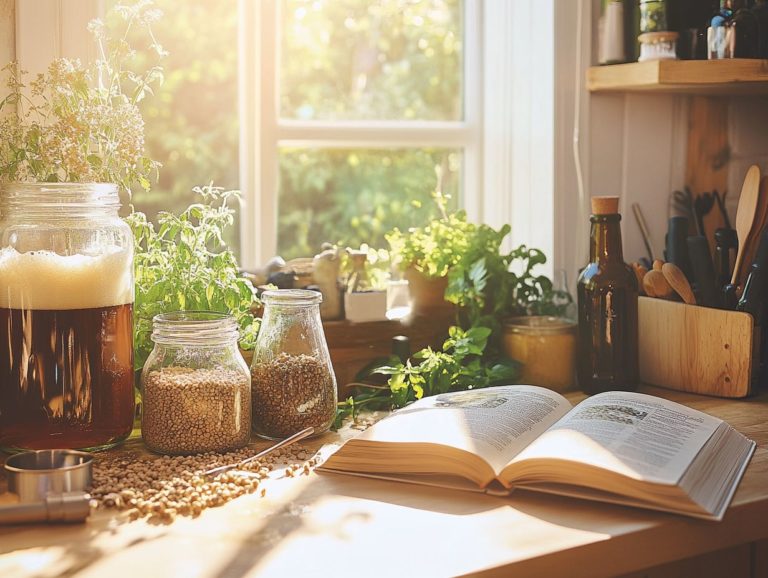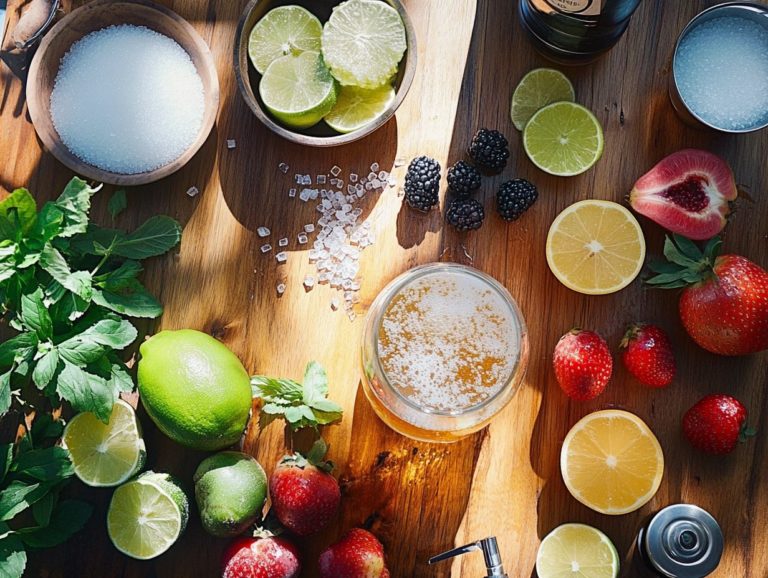Exploring Different Styles of Beer Recipes
Beer enthusiasts and aspiring brewers alike will uncover a wealth of insights within this comprehensive guide to the vibrant world of craft beer.
You ll journey through the spectrum of beer styles, from the comforting embrace of ales and lagers to the deep, complex notes of stouts and the invigorating brightness of IPAs that dance on your palate. The creativity in brewing these styles showcases the diversity and innovation in the beer world.
Delve into the essential ingredients malt, hops, yeast, and water that serve as the foundation of these delightful brews. Learn how to meticulously select the ideal components for your own beer recipes.
With a detailed step-by-step brewing guide at your disposal, you ll also discover innovative tips and strategies to help you avoid common pitfalls along the way. This includes the application of techniques and adjustments to ensure your brewing process is seamless.
Get ready to take your brewing skills to the next level!
Contents
- Key Takeaways:
- Different Types of Beer Styles
- Brewing Essentials
- How to Choose the Right Ingredients for Your Beer Recipe? A Comprehensive Guide
- Step-by-Step Guide to Brewing Beer: From Novice to Expert
- Common Mistakes to Avoid in Beer Brewing
- Frequently Asked Questions
- What are some popular beer styles that I can explore while creating my own recipes?
- What ingredients should I consider when experimenting with different beer recipes?
- How can I learn more about the different styles of beer and their flavor profiles?
- What are the key characteristics of a well-crafted beer recipe?
- Can I mix different beer styles together to create a unique recipe?
- Are there any online resources that can help me in my exploration of different beer recipes?
Key Takeaways:
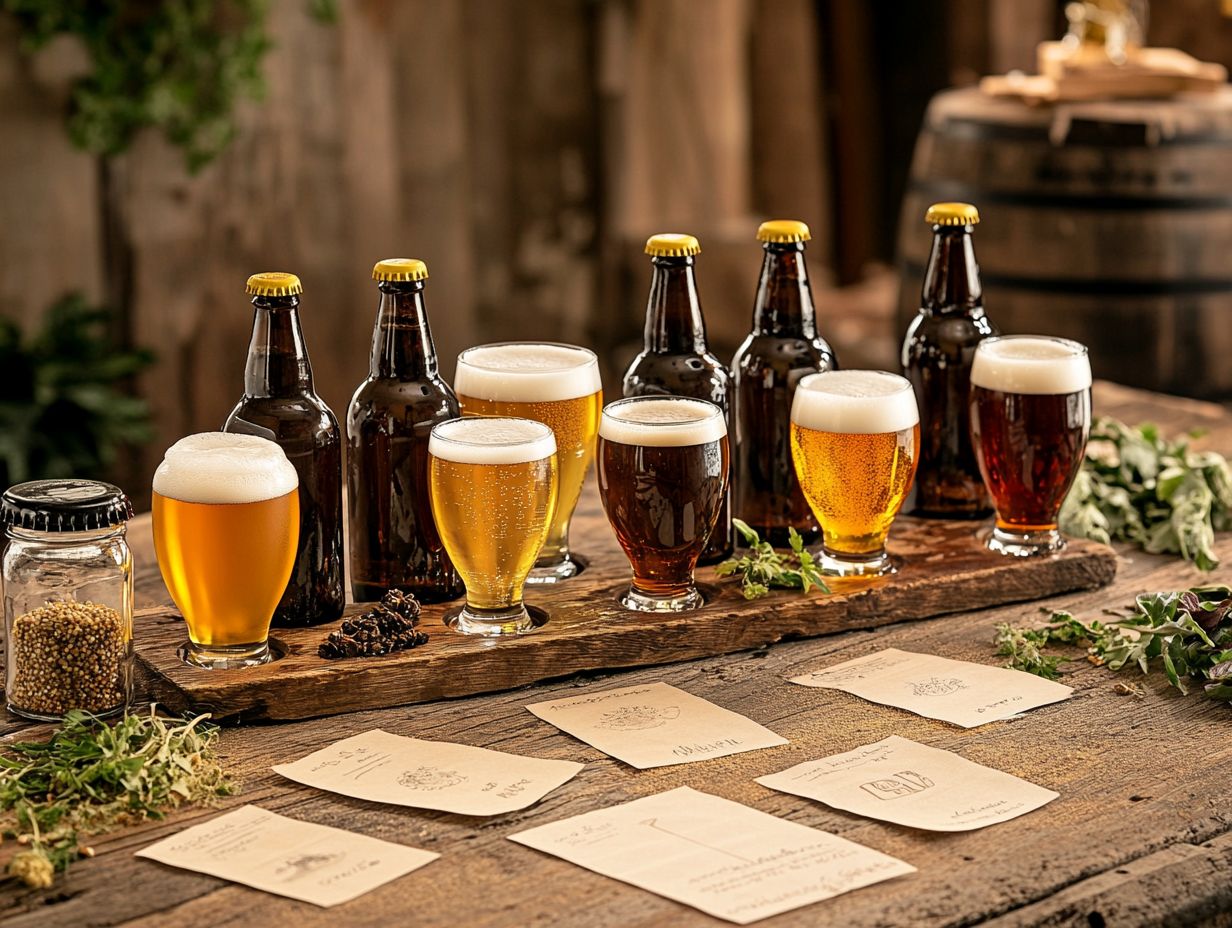
- Discover the diverse world of beer by exploring different styles such as ales, lagers, pilsners, stouts, and IPAs. Each style offers unique flavors and complexities that enhance the beer drinking experience.
- Understand the key ingredients used in beer recipes, including malt, hops, yeast, and water, and how they impact the flavor, aroma, and overall balance of the final brew.
- Create your own unique beer recipes by following a step-by-step guide to brewing and incorporating tips and tricks to avoid common mistakes. Embrace the simplicity and creativity in designing your own brews.
Different Types of Beer Styles
Beer is a remarkable beverage with a rich tapestry of styles, each presenting its own unique characteristics and flavors. Ales, Lagers, Pilsners, Stouts, and IPAs are among the most notable, each embodying distinct brewing techniques, ingredients, and fermentation processes. The diversity in these beer styles showcases the creativity and innovation within the brewing community.
For you, understanding these styles is crucial, whether you’re a homebrewer or a beer enthusiast eager to delve into the intricate world of craft beer. The Beer Judge Certification Program (BJCP) plays a pivotal role by categorizing these styles and offering guidelines for competitions and tasting evaluations. Resources like the BeerSmith software and books by Dr. Brad Smith, Jamil Zainasheff, and Ray Daniels can further aid in your understanding.
This knowledge gives you the power to create balanced recipes, showcasing the best attributes of each beer type.
1. Ales
Ales are a fascinating category of beer distinguished by their warm fermentation process, which typically involves a type of yeast that rises to the top during fermentation. This method gives rise to a wide array of flavors and aromas that can truly elevate your drinking experience. Books such as Radical Brewing and Designing Great Beers provide deep insights into the techniques and creativity involved in brewing ales.
This category includes several sub-styles, each with unique characteristics. For instance, Pale Ales are renowned for their well-balanced malt profile and hoppy bitterness, often showcasing delightful citrus and floral notes. If you re feeling adventurous, India Pale Ales, or IPAs, take this flavor journey to new heights with an intensified hop presence, delivering bold flavors that can evoke images of tropical fruits and resinous pine making them a beloved choice among craft beer aficionados.
Conversely, if you lean towards Belgian Ales, you’ll appreciate their complex yeast profiles that introduce fruity and spicy notes, pairing beautifully with rich dishes like lamb or creamy cheeses. Delving into these styles not only unveils the artistry behind brewing techniques but also enhances the pleasure of discovering perfect food pairings to complement your tasting experience.
2. Lagers
Lagers are celebrated for their crisp, clean taste, crafted using a type of yeast that ferments at the bottom of the fermentation vessel at cooler temperatures. This process leads to that smooth finish you crave.
The brewing techniques for lagers often involve meticulous temperature control and extended fermentation periods. This ensures each lager style is distinct and flavorful.
Among the different types of lagers, Pilsners truly shine with their distinctive golden hue and refreshing bitterness. Originating in the Czech Republic, Pilsners offer a delightful balance of malt sweetness and hop bitterness, often accompanied by floral and herbal notes that dance on your palate.
On the darker side, Dark Lagers, including styles like Dunkel and Schwarzbier, offer a rich explosion of malty flavors enriched with hints of caramel and chocolate. Lagers have historically been central to beer culture, tracing back to the 15th century when brewing techniques began to evolve across Europe.
Each type of lager showcases unique brewing methods, involving a longer fermentation process. This allows the development of their characteristic flavors, ensuring every sip is a must-try experience.
3. Pilsners
Pilsners are a captivating style of Lager that hails from the Czech Republic, celebrated for their golden hue, crisp taste, and distinct hop bitterness. The brewing methods for Pilsners, often involving soft water and herbal hop varieties like Saaz, are well-documented in brewing literature.
The rich history of this cherished beer dates back to the early 19th century, specifically in the city of Pilsen, where innovative brewing techniques first took root. Pilsners are also characterized by a refreshing effervescence, crafted from a harmonious blend of soft water, pale malts, and herbal hop varieties like Saaz.
This combination creates their signature flavor profile, where the clean and floral bitterness stands out, making Pilsners remarkably easy to drink.
As you savor each sip, you re not just enjoying a beverage; you re immersing yourself in a delightful experience that pays homage to both tradition and the artistry of brewing.
4. Stouts
Stouts are dark, rich beers that captivate your senses with their roasted malt, delivering signature flavors of coffee, chocolate, and caramel. These unique brews come in a delightful array of styles, each boasting its own character and complexity.
Take, for example, Dry Stouts; they are renowned for their smooth mouthfeel and slightly bitter finish. This makes them the ideal choice for those who appreciate a lighter yet still robust experience.
If you’re feeling adventurous, Imperial Stouts elevate the game with their higher alcohol content and fuller body, presenting an intense flavor profile that often includes enticing notes of dark fruits and molasses.
The brewing techniques behind these stouts involve meticulous temperature control and extended fermentation periods. This allows for a rich tapestry of flavors to develop.
In terms of food pairings, a Dry Stout harmonizes beautifully with creamy desserts, while a hearty Imperial Stout stands up to rich, savory dishes. This showcases the remarkable versatility and depth that stout varieties bring to the table.
5. IPAs
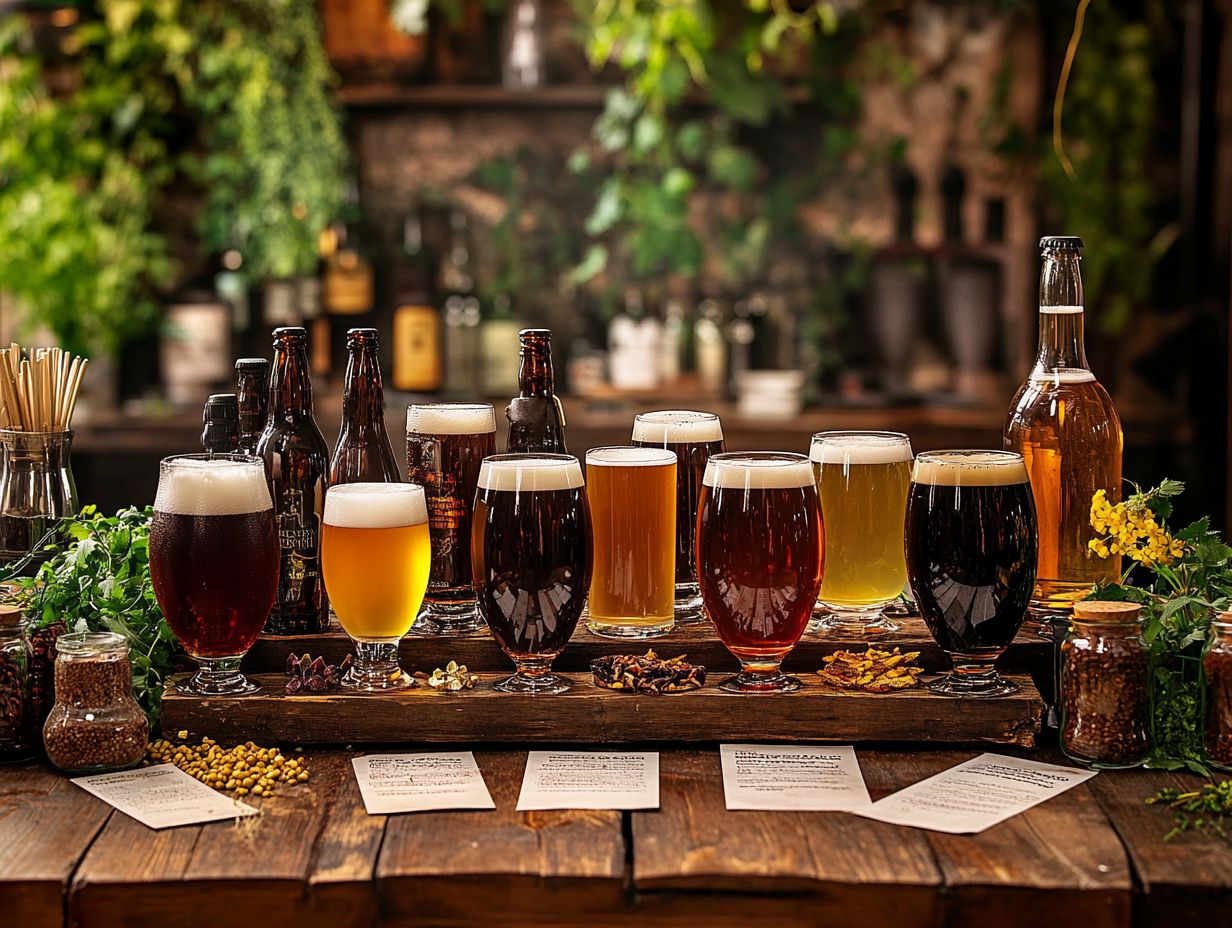
India Pale Ales (IPAs) rank among the most sought-after styles of craft beer, celebrated for their bold hop flavors and aromas that can transport you from floral gardens to vibrant citrus orchards. The choice of hops plays a crucial role in defining these styles, with each variety contributing distinct flavor profiles.
IPAs include a delightful array of unique sub-styles. Each sub-style presents its own distinct tasting journey. For example, West Coast IPAs often boast a bright, piney character, enlivened by resinous and citrus notes. This culminates in a crisp and clean finish that invigorates the palate.
On the flip side, New England IPAs are famed for their hazy allure and juicy mouthfeel. This quality results from strategic late hop additions and dry-hopping techniques that elevate tropical fruit flavors to new heights. Dry-hopping is when hops are added after the boil, enhancing the aroma without adding bitterness. Brewers push boundaries to achieve a harmonious balance and delightful complexity.
The brewing techniques vary significantly, underscoring the importance of ingredients and processes that truly resonate with craft beer enthusiasts like you.
Ingredients Used in Beer Recipes
Brewing beer is an exciting art form that opens up endless possibilities. It hinges largely on your selection of high-quality ingredients, which are pivotal in shaping the beer’s flavor, aroma, and overall character. Resources like White Labs and Wyeast offer a variety of yeast strains that can significantly influence your brewing outcomes.
Your primary ingredients malt, hops, yeast, and water each bring their own unique attributes to the final brew. Malt is your source of sugars necessary for fermentation, providing both body and sweetness to the beer. Hops introduce bitterness and aroma, skillfully balancing out the malt’s sweetness.
Yeast takes on the vital role of fermentation, transforming those sugars into alcohol and carbon dioxide. Understanding these ingredients is essential for you as you craft a successful beer recipe.
1. Malt
Malt stands as a cornerstone in the brewing of beer, supplying the essential sugars needed for fermentation while also shaping the beer s color, flavor, and body. The use of different malt varieties, such as Munich malt, plays a vital role in achieving the desired balance and complexity in your beer recipes.
Different varieties of malt, like Munich and Pale malt, play pivotal roles in defining the unique character of various beer styles. Munich malt, with its rich, malty sweetness, is often favored for darker lagers, where it is vital in achieving a fuller mouthfeel. On the other hand, Pale malt serves as the foundational element for many ales, imparting light flavors and a well-rounded sweetness.
The meticulous processing of malt encompassing kilning and roasting significantly influences its color and flavor profile. This culminates in the complex notes present in the finished product. The Maillard reaction, a delightful transformation during the heating process, further intensifies these flavors, introducing rich, toasty characteristics that are essential for crafting distinctive and memorable brews.
Brewing Essentials
2. Hops
Hops are enchanting flowers that elevate your brewing game. They impart essential bitterness, flavor, and aroma, creating a harmonious balance with the sweetness of the malt.
The right hops can significantly influence your beer recipe. They bring out unique bitterness and aroma profiles.
These delicate blooms come from the Humulus lupulus plant and include many varieties. Each variety contributes unique traits to your final product.
For example, Cascade hops are celebrated for vibrant floral and citrus notes. They are a staple in American Pale Ales.
On the other hand, the earthy, spicy character of Saaz hops beautifully complements traditional European lagers.
The timing of your hop additions during brewing is crucial. Adding them at the beginning boosts bitterness, while adding them at the end elevates aroma.
The percentage of hops you choose intricately alters the overall bitterness and complexity. Higher alpha acid content leads to more pronounced bitterness that can either complement or overshadow the sweet notes of the malt.
3. Yeast and Fermentation Techniques
Yeast is essential in beer brewing. It transforms sugars into alcohol and carbon dioxide, imparting distinct flavors to your brew.
Different yeast strains, such as those from White Labs or Wyeast, offer unique characteristics. They can enhance the complexity of your final product.
Brewing yeast falls into two primary categories: ale yeast and lager yeast. Ale yeasts are typically top-fermenting, thriving at warmer temperatures and resulting in fruity flavors associated with beloved beer styles like IPAs and stouts.
Lager yeasts are bottom-fermenters that flourish in cooler conditions. They create a cleaner and crisper taste profile.
The choice of yeast shapes the character of the beer and influences mouthfeel and overall drinkability. This makes it a vital consideration for any brewer aiming to master specific styles.
4. Water
Water might seem straightforward, but its mineral content and pH can profoundly influence both the brewing process and the final taste of your beer.
Subtle nuances in water chemistry can elevate flavors, especially in distinctive styles like IPAs and stouts. For instance, if your water has a higher sulfate content, it can enhance the crisp bitterness found in pale ales.
A calcium-rich profile can bestow a smooth mouthfeel to darker beers. Conversely, an excess of chloride can dull the hop character, leading to a less desirable balance.
By grasping these intricate relationships, you can intentionally craft your water composition. This results in a brew that is both well-rounded and harmonious.
In this way, water chemistry is integral to defining the craft and quality of each unique batch you create. This understanding can give you an edge in homebrewing competitions, where minute differences are often critical.
How to Choose the Right Ingredients for Your Beer Recipe? A Comprehensive Guide
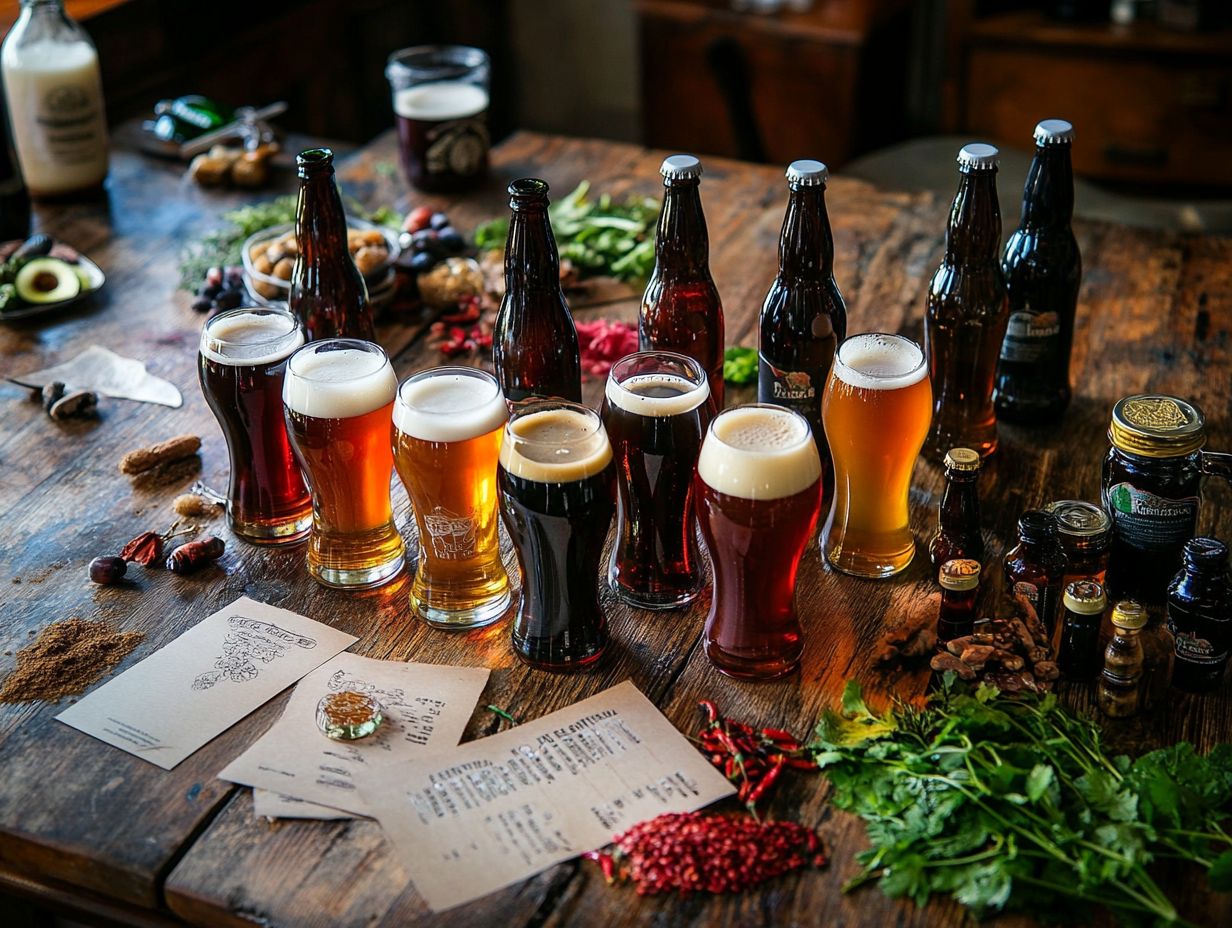
Choosing the right ingredients for your beer recipe is crucial in achieving the flavors, aromas, and overall balance you desire. This is an essential step in your brewing journey. Reading books like “Radical Brewing” by Randy Mosher and “Designing Great Beers” by Ray Daniels can offer valuable insights and inspire your creativity.
When selecting the perfect ingredients, it’s important to consider your personal preferences and the style of beer you want to create. Different styles demand distinct flavor profiles and aromas. For instance, if you’re crafting a hoppy IPA, you’ll need bold hops, while a smooth lager will call for more subtle options.
Ingredient availability also plays a vital role. Tapping into local suppliers may introduce you to seasonal or unique ingredients that can elevate your brew.
Understanding how to adjust proportions and make appropriate substitutions such as experimenting with different malts or tweaking hop quantities will help ensure your final product retains its intended character. Striking this balance is key to crafting a beer that is enjoyable and reflects your brewing vision.
Step-by-Step Guide to Brewing Beer: From Novice to Expert
Brewing your own beer is an exhilarating adventure that anyone can embark on! It encompasses several essential steps that demand your careful attention to detail and a solid grasp of various techniques, from mashing to fermentation. By mastering these stages, you can elevate your brewing game whether you re a novice or a seasoned brewer crafting flavorful beers that reflect your creativity and skill.
The primary steps include:
- Mashing with precise temperature control
- Boiling
- Fermentation
- Conditioning
Each step requires specific equipment and ingredients to achieve the results you desire. Adhering to a structured brewing schedule not only helps maintain consistency but also ensures the quality of your homebrew shines through in every sip.
1. Mashing
Mashing is the artful process where you blend crushed grains, primarily malt, with hot water to activate enzymes that transform starches into fermentable sugars. This lays the groundwork for your beer’s flavor profile.
The selection of grains, such as Munich malt or pale barley, can significantly affect the final outcome, contributing to the complexity of your brew. This essential stage demands precise temperature control, as different enzymes flourish at specific temperatures, greatly influencing conversion efficiency.
For example, when you hit around 152 F (67 C), alpha-amylase an enzyme that helps convert starches into sugars reaches peak activity. This produces a fuller-bodied beer with rich, complex flavors. Conversely, cranking up the temperature can yield fewer fermentable sugars, leading to a drier finish.
The thickness of your mash can significantly affect the outcome. A thicker mash often results in a more concentrated wort, improving sugar extraction and ultimately enhancing the overall quality and character of your final brew.
2. Boiling
The boiling stage is a pivotal moment in your beer brewing process. During this stage, the wort undergoes sterilization, and hops are introduced to infuse the beer with essential bitterness and flavor. Utilizing different hop varieties, such as Centennial hops, can add unique flavors and aromas to your beer.
During this critical phase, you ll typically boil the wort for anywhere between 60 to 90 minutes, tailored to your specific recipe and the characteristics you aim to achieve. Hops play a vital role here, as they are added at various points throughout the boil. Early additions primarily focus on imparting bitterness, while hops added later enhance the overall flavor and aroma profiles.
Techniques like dry hopping and whirlpool hopping allow you to elevate the complexity of your brew. These methods give you the freedom to experiment with different hop varieties and timing. Each method you choose can significantly transform the final product, resulting in an impressive array of aromatic and flavorful experiences.
3. Fermentation
Fermentation is the pivotal stage in brewing where yeast transforms sugars into alcohol and carbon dioxide, crafting distinctive flavors in your beer. Utilizing yeast strains like WLP001 (American Ale II) can result in a cleaner and crisper beer.
This complex process unfolds in two main stages: primary and secondary fermentation. During the primary phase, yeast enthusiastically consumes the sugars, often leading to a noticeable rise in temperature, influenced by factors such as the health of the yeast and the concentration of the original wort.
Following this, secondary fermentation offers a more deliberate maturation period, helping flavors blend together while unwanted byproducts settle. By employing various fermentation techniques such as precise temperature control through cooling systems and the use of different yeast strains you can dramatically influence the overall taste and aroma profile, enhancing your unique brewing craft and sparking innovation.
4. Conditioning
Conditioning marks the final stage in brewing. It s a crucial time when your beer matures, clarifies, and develops its full flavor profile before it s ready for packaging.
During this essential phase, you ll encounter various methods like bottle conditioning and keg conditioning, each presenting unique benefits. With bottle conditioning, you add a touch of sugar and yeast to the beer before sealing it in bottles. This contributes to carbonation and elevates the complexity of flavors as secondary fermentation unfolds in that sealed environment.
On the other hand, keg conditioning allows for controlled carbonation, leading to a distinct mouthfeel and aromatic profile. This gives you the flexibility to create your desired outcome. The effects of these methods on the overall taste and bouquet of your beer are significant, often resulting in a richer and more nuanced drinking experience.
Tips and Tricks for Creating Unique Beer Recipes: Innovation and Simplicity
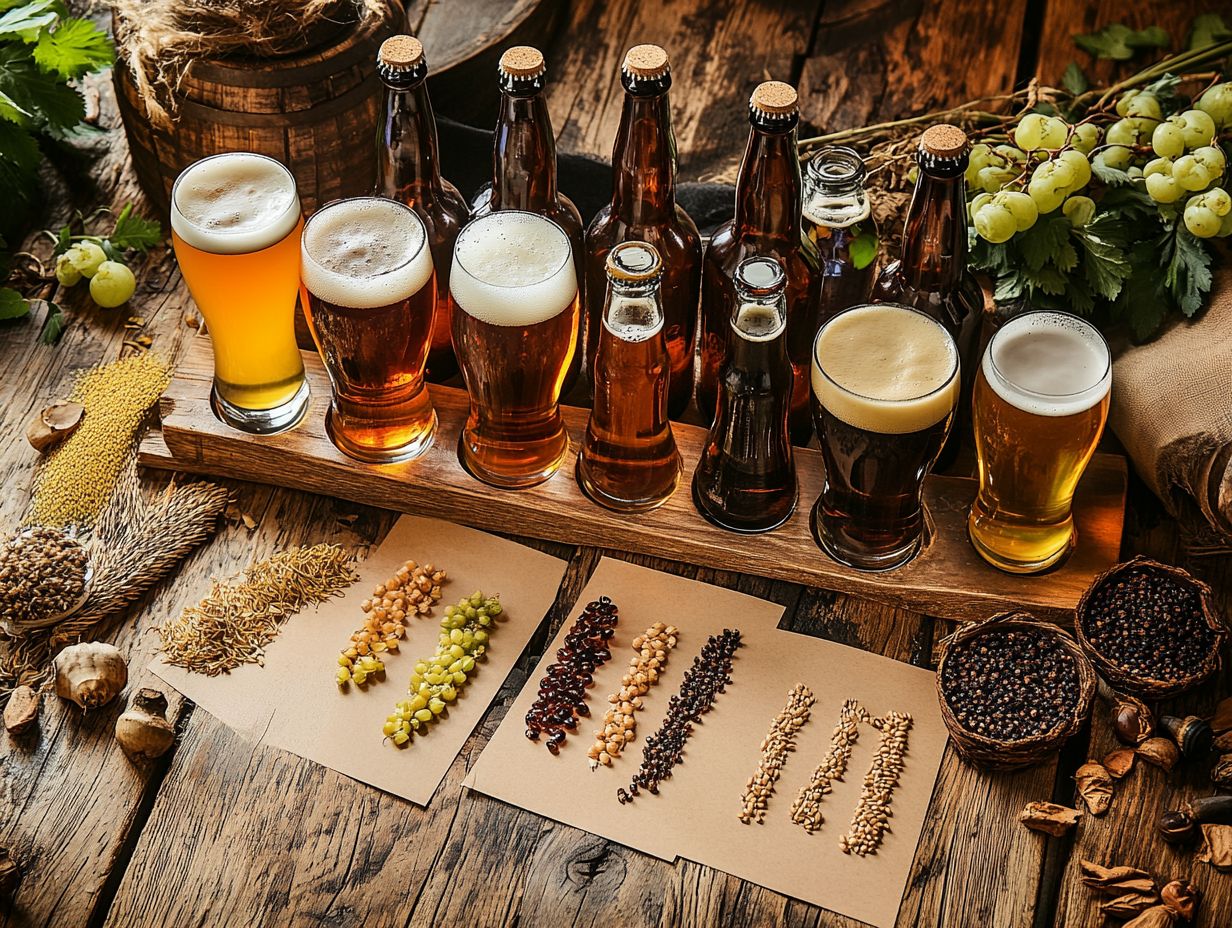
Creating unique beer recipes is an art that marries creativity with experimentation, grounded in a solid understanding of basic brewing principles. This combination allows you to craft distinctive flavors that truly stand out. Many brewers often look to the BJCP guidelines to design their recipes and compete in brewing competitions.
To achieve culinary excellence, explore the intricacies of ingredient substitutions for malt, hops, and yeast, as these choices can dramatically alter the flavor profile of your final product. Grasping the roles that various ingredients play is crucial; for example, opting for caramel malts instead of pale malts can infuse your brew with added sweetness and rich color. When adjusting proportions, maintaining balance is key too much of one element can easily overshadow the others. Understanding the water chemistry and its impact on the brewing process is essential to achieving the desired results.
Experiment with different brewing techniques, such as dry hopping or varying fermentation temperatures. You ll be amazed at the delightful results that come from these small tweaks! For instance, using Munich malt and Centennial hops can create a unique beer style that stands out in competitions.
Ultimately, immersing yourself in thorough research and nurturing a genuine passion for flavors will empower you to refine your craft and develop exceptional beer recipes. Reading books like “Radical Brewing” by Randy Mosher or “Designing Great Beers” by Ray Daniels, along with exploring different styles of beer recipes, can provide valuable insights and inspiration.
Common Mistakes to Avoid in Beer Brewing
Avoiding common mistakes in beer brewing is essential for achieving a high-quality finished product. Even the smallest errors can lead to off-flavors and undesirable characteristics that detract from your vision. Utilizing software like BeerSmith, developed by Dr. Brad Smith, can help you fine-tune your brewing process and avoid common pitfalls.
To ensure each brew truly reflects your intent, concentrate on several key areas. One of the most frequent pitfalls is poor sanitation. Neglecting proper cleaning techniques risks introducing unwanted bacteria that can compromise both the flavor and clarity of your beer.
Inadequate control over fermentation can also lead to stuck fermentation or off-flavors due to temperature fluctuations. Getting the right proportions of ingredients is crucial. Too much or too little can ruin your beer!
Establish a strict sanitation routine to mitigate these issues. Monitor fermentation temperatures closely and measure your ingredients with precision. By implementing these practices, you can dramatically elevate your brewing process and impress your friends with exceptional beer!
Frequently Asked Questions
What are some popular beer styles that I can explore while creating my own recipes?
Some popular beer styles you can explore include IPAs, stouts, lagers, pale ales, wheat beers, and Belgian ales.
What ingredients should I consider when experimenting with different beer recipes?
When experimenting with different beer recipes, consider using various types of malt, hops, yeast, and specialty ingredients like fruits, spices, and herbs.
How can I learn more about the different styles of beer and their flavor profiles?
Learn more about different beer styles and their flavor profiles by attending beer tastings, reading books on beer, and talking to experienced brewers. Renowned figures like Jamil Zainasheff and organizations like the Beer Judge Certification Program (BJCP) offer valuable resources for expanding your knowledge.
What are the key characteristics of a well-crafted beer recipe?
A well-crafted beer recipe should have a balance of malt and hop flavors, a clear and appropriate color, a suitable level of carbonation, and a smooth and pleasing mouthfeel.
Can I mix different beer styles together to create a unique recipe?
Yes, you can mix different beer styles to create a unique recipe. This is known as a beer blend and can result in interesting and complex flavors. Many homebrewers experiment with Single Malt and Single Hop (SMaSH) approaches to simplify the brewing process while exploring new flavor combinations.
Are there any online resources that can help me in my exploration of different beer recipes?
Yes, many online resources can assist you in exploring different beer recipes. You can find recipe databases, forums for homebrewers, and educational websites on beer styles and brewing techniques. Websites like the Homebrewers Association and platforms like BeerSmith offer extensive resources for both novice and experienced brewers.

